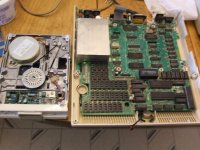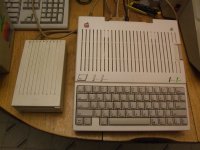HoJoPo
Veteran Member
So, I decided I needed an Apple IIc for my collection, since the early Apple ][ Plus, enhanced Apple //e, Rom 01 Woz IIgs, Rom 03 IIgs and IIc+ might be lonely.
Trolling around on eBay, I found a VERY dirty IIc "for parts", along with a bunch of floppy disks, a Kraft KC3+ joystick, a PC 720 half height 3.5" drive, and a Unidisk 3.5.
I managed to get it, bidding exactly the same as the other bidders top bid. $50+$45 shipping later, I received the Apple IIc today.
It was VERY dirty, sticky greasy dirt on all top surfaces of the IIc, Unidisk and Joystick. The disks turned out to be a HUGE collection of late 80's / early 90's Computer Science / Math software for the PC, including assemblers, Pascal, C and Modula-2 compilers, and a bunch more, all on high density 5.25 floppies. Unfortunately, not much use in the IIc.

I powered up the IIc and Unidisk, and it immediately made popping noises from the 3.5 drive, trying to eject a disk. There was a DD PC formatted programming scratch disk in it, good thing, the disk protected the heads. It was only stuck in there by the label, so I fished it out and stuck in a 3.5 Apple II Diagnostics v4.1 disk.
The IIc passed the first few tests, then locked up. It would barely pass the tests, the fail the next pass, over and over. So, I decided to take it apart and see what was wrong. I found something amazing in it once I removed the floppy and keyboard:


That's right, it has a Z-Ram Ultra 3 in it! One of the ultimate IIc accessories. But, oddly, it has no RAM on it, all the sockets are empty.
I take it out, finding that it uses stacked sockets to raise the CPU / MMU sockets to the necessary height. So I remove the MMU and CPU from the Z-Ram, and put them in the stacked sockets. It immediately locks up, won't even boot, just a screen full of gibberish.
So, I remove the sockets, and install the CPU/MMU directly on the motherboard. It passes all the tests, over 25 passes without issues! One of the riser sockets is a cheap generic, and I just happen to have an extra 40 pin DIP machine pin socket from my TWGS troubleshooting... so I install the sockets, re-install the Z-Ram (with MMU/CPU relocated to it), and try it out.
Immediately, it crashes in testing again. Ok, so the sockets weren't the only problem... I wonder. AE always shipped the Z-Ram Ultra 3 with a minimum of 256k memory. Maybe the MMU isn't happy without at least one bank of RAM.
Ok, so the sockets weren't the only problem... I wonder. AE always shipped the Z-Ram Ultra 3 with a minimum of 256k memory. Maybe the MMU isn't happy without at least one bank of RAM.
So, I open up the II plus, and pull out the RamFactor 1MB card. I yank a bank of RAM off of it, and put it in bank "A" of the Z-Ram. Note: the Ultra 3 has the ram chips opposite the other two versions, pay close attention to the chip sockets! Good thing I check the documentation first (Thanks Dr. Ken, your document archive came in handy.)
Boot it up, and, joy, it passes! :D So, I figure, why not put all 1 MB in it while I have it apart, it's a lot easier to put it in now. Of course, one pin, on the very last of 32 RAM chips, bends instead of going in. But, with some careful needlenose work, I got it straightened out and inserted.
But, with some careful needlenose work, I got it straightened out and inserted.
Ran it for 100 passes on the AE Ram test utility, no issues! It's running the Apple diagnostics now, testing the CPU/RAM/MMU and serial port (internal test)... I'll let it run for a bit, so hopefully it can charge the 3.6v battery for the clock.
Oh, and the clock utility recognizes and sets the clock fine as well. Thanks to the extra disks that Dr. Buggie sent with some IIe stuff I bought, I already had the necessary software for it.
I also spent about an hour cleaning it and all the keys with rubbing alcohol, it looks a lot better now:

Now to find CP/AM 5.1 to test the Z-80 capabilities...
Trolling around on eBay, I found a VERY dirty IIc "for parts", along with a bunch of floppy disks, a Kraft KC3+ joystick, a PC 720 half height 3.5" drive, and a Unidisk 3.5.
I managed to get it, bidding exactly the same as the other bidders top bid. $50+$45 shipping later, I received the Apple IIc today.
It was VERY dirty, sticky greasy dirt on all top surfaces of the IIc, Unidisk and Joystick. The disks turned out to be a HUGE collection of late 80's / early 90's Computer Science / Math software for the PC, including assemblers, Pascal, C and Modula-2 compilers, and a bunch more, all on high density 5.25 floppies. Unfortunately, not much use in the IIc.

I powered up the IIc and Unidisk, and it immediately made popping noises from the 3.5 drive, trying to eject a disk. There was a DD PC formatted programming scratch disk in it, good thing, the disk protected the heads. It was only stuck in there by the label, so I fished it out and stuck in a 3.5 Apple II Diagnostics v4.1 disk.
The IIc passed the first few tests, then locked up. It would barely pass the tests, the fail the next pass, over and over. So, I decided to take it apart and see what was wrong. I found something amazing in it once I removed the floppy and keyboard:


That's right, it has a Z-Ram Ultra 3 in it! One of the ultimate IIc accessories. But, oddly, it has no RAM on it, all the sockets are empty.
I take it out, finding that it uses stacked sockets to raise the CPU / MMU sockets to the necessary height. So I remove the MMU and CPU from the Z-Ram, and put them in the stacked sockets. It immediately locks up, won't even boot, just a screen full of gibberish.
So, I remove the sockets, and install the CPU/MMU directly on the motherboard. It passes all the tests, over 25 passes without issues! One of the riser sockets is a cheap generic, and I just happen to have an extra 40 pin DIP machine pin socket from my TWGS troubleshooting... so I install the sockets, re-install the Z-Ram (with MMU/CPU relocated to it), and try it out.
Immediately, it crashes in testing again.
So, I open up the II plus, and pull out the RamFactor 1MB card. I yank a bank of RAM off of it, and put it in bank "A" of the Z-Ram. Note: the Ultra 3 has the ram chips opposite the other two versions, pay close attention to the chip sockets! Good thing I check the documentation first (Thanks Dr. Ken, your document archive came in handy.)
Boot it up, and, joy, it passes! :D So, I figure, why not put all 1 MB in it while I have it apart, it's a lot easier to put it in now. Of course, one pin, on the very last of 32 RAM chips, bends instead of going in.
Ran it for 100 passes on the AE Ram test utility, no issues! It's running the Apple diagnostics now, testing the CPU/RAM/MMU and serial port (internal test)... I'll let it run for a bit, so hopefully it can charge the 3.6v battery for the clock.
Oh, and the clock utility recognizes and sets the clock fine as well. Thanks to the extra disks that Dr. Buggie sent with some IIe stuff I bought, I already had the necessary software for it.
I also spent about an hour cleaning it and all the keys with rubbing alcohol, it looks a lot better now:

Now to find CP/AM 5.1 to test the Z-80 capabilities...
